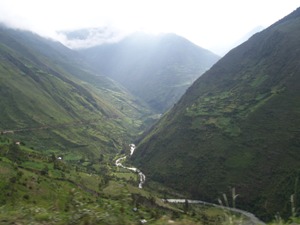Leftist guerrillas of the Shining Path killed 14 Peruvian soldiers in a pair of ambushes in Ayacucho province, in the remote and rugged coca-growing region of the VRAE (ApurÃmac and Ene River valleys) last week, and they are vowing to do it again. Last week's attack on the military was the deadliest since last October, when 13 soldiers and two civilians were killed in an ambush of a military convoy in neighboring Huancavelica province.

At its height, the Shining Path fielded 10,000 men, with countless thousands of supporters providing infrastructure, but today its numbers of armed combatants are estimated to be between 300 and 500. It is widely held that the group has largely shed its ideology and settled in to a life as a criminal drug trafficking organization. But it can still talk the talk.
"We will fight militarily those who defend imperialism and the government, and they are the armed forces and the police," Victor Quispe Palomino, who identified himself by his rebel name, Comrade José, said in a call to a radio station, Reuters reported.
The ambushes and threats are the group's strongest response yet to a Peruvian government effort to retake control of the VRAE, where some 40,000 families earn a living from coca fields. Since that effort got underway last August, at least 33 soldiers have been killed.
The move in the VRAE is part and parcel of President Alan GarcÃa's broader effort to suppress coca production through eradication programs backed by the US. The world's second largest coca producer, Peru receives funds from the US for its eradication programs. GarcÃa's plan also includes building schools and hospitals in remote towns, but it seems the army has a greater presence than the government's development teams.
But the Shining Path is also showing signs of deep pockets. Like the Taliban in Afghanistan, it is profiting from prohibition, and the results can be deadly, said critics of GarcÃa's program. "The Shining Path is using more and more fire power in each attack," Fernando Rospigliosi, a former interior minister, told RPP Radio in Lima. "The plan has not produced results and the government keeps on insisting on the wrong strategy."
The situation was "unacceptable," said ex-Army chief Edwin Donayre. "There are principles applicable to conventional warfare that do not suffice for non-conventional war," he told RPP. "We have zero results so we need to reconfigure our strategy."
But President GarcÃa is talking tough. "The terrorists won't hold us back," GarcÃa said. "Our armed forces are trained to smash them."
Comments
If they were U.S. backed peruvian soldiers.... good job!
Quote: "There are principles applicable to conventional warfare that do not suffice for non-conventional war,". Asshole got that much right anyway!
Government terrorists won't hold us back.
Gone Guerilla!
Mogilla Rules
Delusional?
He has done a great job, so far, in showing the rebels who's the boss! I guess his armed forces might need some additional training, if they don't want to keep getting their asses kicked!!
Add new comment